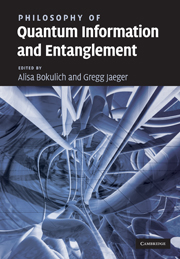Book contents
- Frontmatter
- Contents
- List of contributors
- Preface
- Introduction
- Part I Quantum entanglement and non-locality
- Part II Quantum probability
- Part III Quantum information
- Part IV Quantum communication and computing
- 11 Quantum computation: Where does the speed-up come from?
- 12 Quantum mechanics, quantum computing, and quantum cryptography
- Index
11 - Quantum computation: Where does the speed-up come from?
from Part IV - Quantum communication and computing
Published online by Cambridge University Press: 04 August 2010
- Frontmatter
- Contents
- List of contributors
- Preface
- Introduction
- Part I Quantum entanglement and non-locality
- Part II Quantum probability
- Part III Quantum information
- Part IV Quantum communication and computing
- 11 Quantum computation: Where does the speed-up come from?
- 12 Quantum mechanics, quantum computing, and quantum cryptography
- Index
Summary
Introduction
Discussions of quantum-computational algorithms in the literature refer to various features of quantum mechanics as the source of the exponential speed-up relative to classical algorithms: superposition and entanglement, the fact that the state space of n bits is a space of 2n states while the state space of n qubits is a space of 2n dimensions, the possibility of computing all values of a function in a single computational step by “quantum parallelism,” or the possibility of an efficient implementation of the discrete quantum Fourier transform. Here I propose a different answer to the question posed in the title, in terms of the difference between classical logic and quantum logic, i.e., the difference between the Boolean classical event structure and the non-Boolean quantum event structure. In a nutshell, the ultimate source of the speed-up is the difference between a classical disjunction, which is true (or false) in virtue of the truth values of the disjuncts, and a quantum disjunction, which can be true (or false) even if none of the disjuncts is either true or false.
In the following, I will discuss the information-processing in Deutsch's XOR algorithm (the first genuinely quantum algorithm) and related period-finding quantum algorithms (Simon's algorithm and Shor's factorization algorithm). It is well known that these algorithms can be formulated as solutions to a hidden-subgroup problem. Here the salient features of the information-processing are presented from the perspective of the way in which the algorithms exploit the non-Boolean logic represented by the projective geometry (the subspace structure) of Hilbert space.
Information
- Type
- Chapter
- Information
- Philosophy of Quantum Information and Entanglement , pp. 231 - 246Publisher: Cambridge University PressPrint publication year: 2010
Accessibility standard: Unknown
Why this information is here
This section outlines the accessibility features of this content - including support for screen readers, full keyboard navigation and high-contrast display options. This may not be relevant for you.Accessibility Information
- 6
- Cited by
